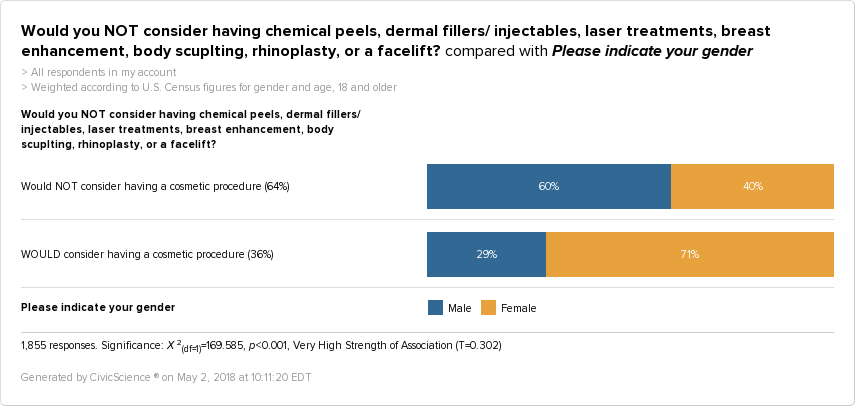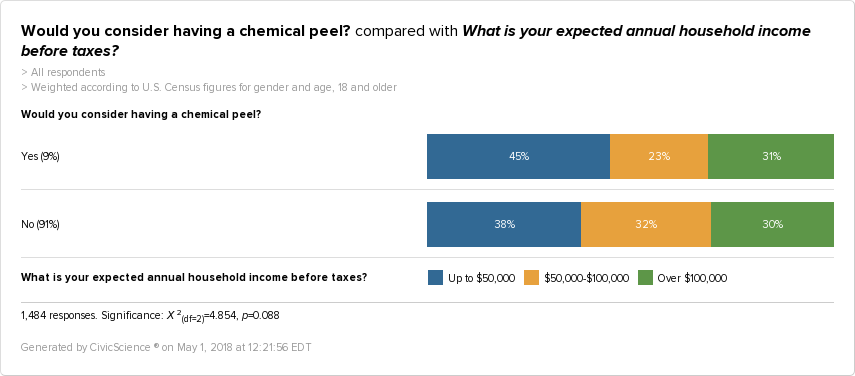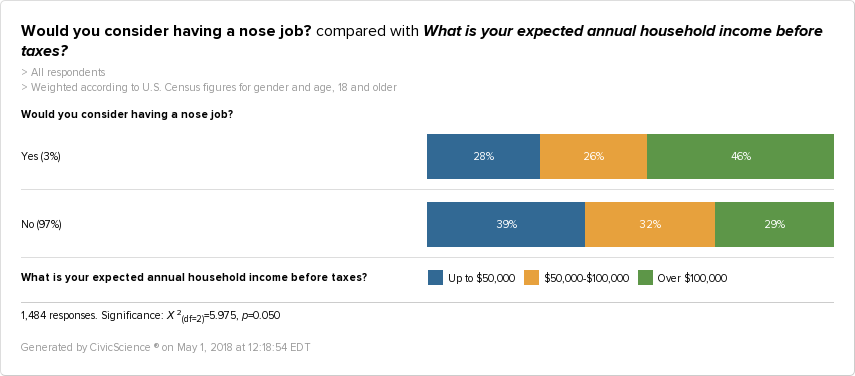The Gist: Cosmetic procedures are not just for rich and famous (women) anymore. We found over a third of US adults are interested in getting a cosmetic procedure of some kind. Treatments are attracting interest from men, lower income earners, and especially Generation X. Hello, midlife crisis.
In recent years, plastic surgery and medical spa procedures–think non-invasive aesthetic treatments–have become more and more common. What was once solely reserved for the Hollywood elite is now popping up in more mainstream conversations than ever before. At least, that’s what social media and our own anecdotal experience seem to indicate. So of course, we wanted to put some firm data behind the hype and take the pulse of interest in cosmetic procedures in 2018.
We began by asking US adults if they would consider a variety of different invasive and non-invasive cosmetic procedures.
While 64% had no interest, we found that 36% of US adults would consider having some form of cosmetic procedure. That substantial amount of interest supports the general belief that plastic surgery and medspa treatments are, in fact, not just of interest to a select few.
When we broke down the respondents who answered that they were interested in cosmetic procedures by gender, here is what we found:
The important takeaway is this: of those US adults who are interested in some form of cosmetic procedure, 71% are women and 29% are men. Considering the fact that the anti-aging industry has long been marketed towards women, this statistic could further support the notion that looking good is not just a priority for half the population anymore.
So now we know that cosmetic procedures have the attention of 36% of US adults. But who are these adults? Could the interest just be coming from the rich and famous?
As it turns out, probably not. While interest is fairly uniform in the $50k and up crowd, we see a slight spike in interest from those who make less than $50k a year.
US adults who make less than $50,000 a year make up 39% of those who would consider having a cosmetic procedure. Considering the historic reputation many of these procedures have as carrying an exceptionally high price tag, this news could indicate that low-to-mid income earners are prioritizing appearance, that procedure costs are becoming more accessible, or both.
That said, it appears there could be some connection between perceived treatment cost and income level interest. For example, chemical peels–non-invasive facial treatments that remove the outer layers of the skin–are largely popular with the under $50k set.
By contrast, interest in nose jobs–invasive surgical procedures to reshape and improve the appearance and occasionally function of the nose–is overwhelmingly from those who make more than $100,000 annually.
All of this is to say that while some cosmetic procedures are clearly becoming more accessible and mainstream, there are still those that seem off limits for the average person. So while it’s true that cosmetic procedures are beloved by individuals in all income levels, the specific interest does have some correlation to income.
Okay, enough about money. In 2018, there are countless beauty companies focusing on aging gracefully and naturally–essentially the opposite of what a cosmetic procedure promises. So, which age ranges are the most interested in maintaining their youth with a little boost from modern medicine?
Turns out, the midlife crisis may be a real thing, with 43% of US adults who are interested in cosmetic procedures hailing from Generation X. Millennials are not far behind, coming in at 33%. This midlife crisis phenomenon is true beyond appearance: we recently found that Gen Xers are also more likely to be unsatisfied with their highest level of education.
Earlier this year, we surveyed opinions on retouching in advertising. Out of that inquiry, the largest percentage of US adults who believed we should retouch less in advertising were Gen X-ers. So, while the 35-54 set may disapprove of retouching models for the purpose of selling a product, they largely approve of retouching in real life with the use of cosmetic procedures.
This poses an interesting challenge for plastic surgeons and medical spas, whose biggest potential client base also happens to be the most critical of the general concept of retouching. Perhaps it all comes down to the way the services are presented? Or perhaps Gen X-ers have justified their conflicting beliefs thanks to the boost of confidence they feel after a procedure that leaves them looking younger and more glowy than before? Who knows. Body modifications are, after all, a very personal choice.
So where does this leave us? Well, for starters, men are interested in cosmetic procedures, too, which means that marketing needs to address everyone–not just women anymore.
We should also note that some–but not all–cosmetic procedures are garnering more interest from lower-income individuals. With this in mind, plastic surgery centers and medical spas may want to ensure they have financing options or a range of services available to pique the interest of this potential client base. Long-term, the name of the game could be building loyalty. After one successful chemical peel, that same patient may come back for a facelift a few years down the road. Who knows? Getting customers in the door is always the first step.
And finally, when it comes to the relationship that Generation X has with appearance, it’s complicated. Gen X-ers want the procedures but may not want to see advertising that includes models who look like they’ve had the same procedures themselves. In any case, at least according to our data, interest in cosmetic procedures should not be taken for granted, as it shows no sign of slowing down any time soon.













